
How to Use A-STAR 32U4 Micro: Examples, Pinouts, and Specs
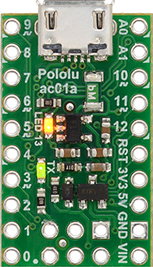
 Design with A-STAR 32U4 Micro in Cirkit Designer
Design with A-STAR 32U4 Micro in Cirkit DesignerIntroduction
The A-STAR 32U4 Micro (manufacturer part ID: ac01a) is a compact and versatile microcontroller board developed by Pololu. It is based on the ATmega32U4 microcontroller, which features built-in USB connectivity, making it an excellent choice for projects requiring direct communication with a computer. With 32KB of flash memory, 2.5KB of SRAM, and a small form factor, the A-STAR 32U4 Micro is ideal for embedded systems, robotics, and other space-constrained applications.
Explore Projects Built with A-STAR 32U4 Micro
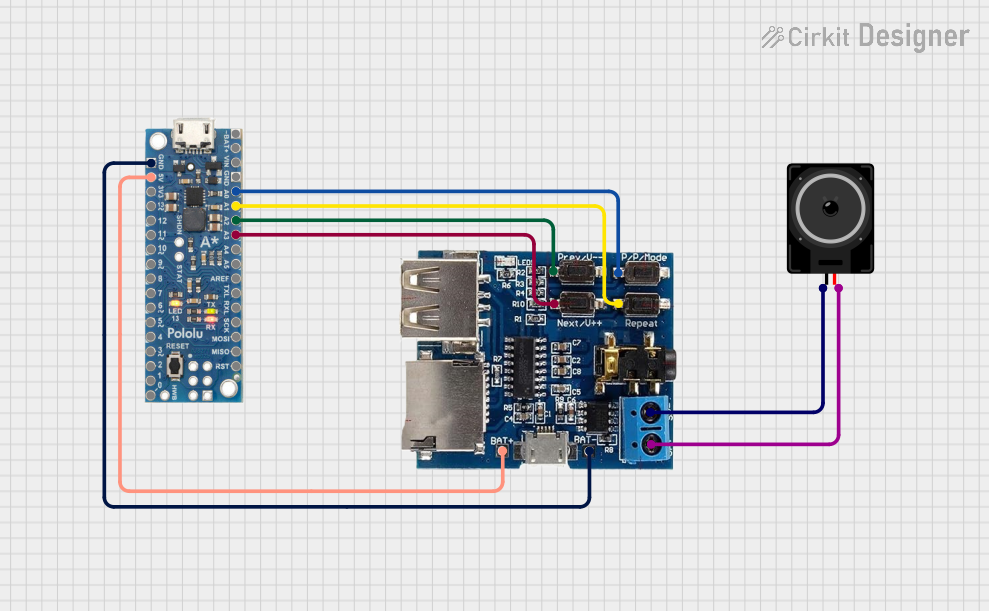
 Open Project in Cirkit Designer
Open Project in Cirkit Designer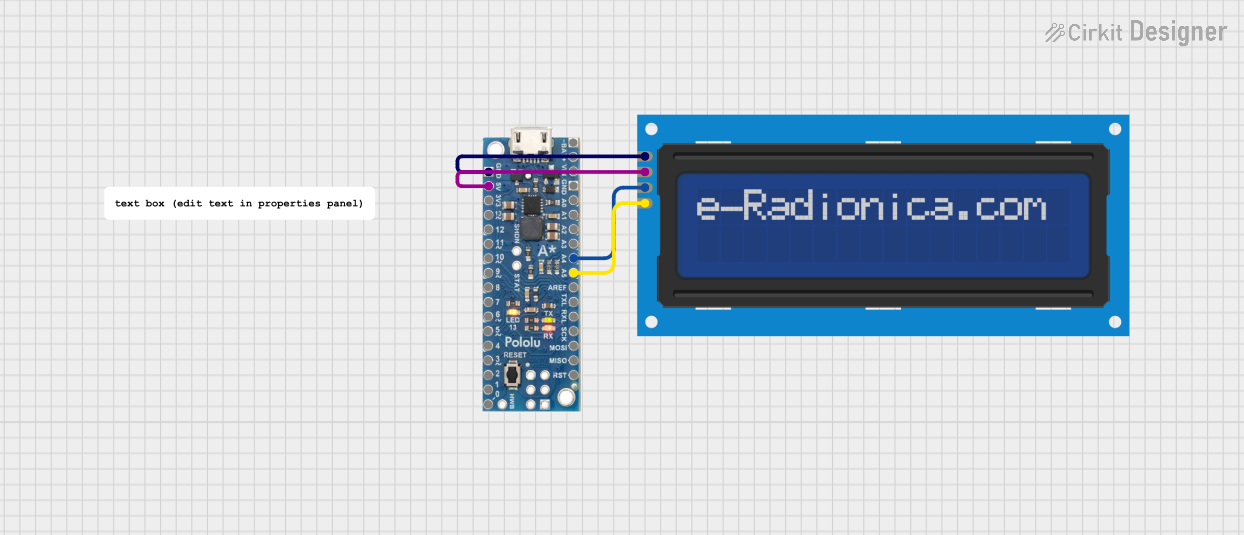
 Open Project in Cirkit Designer
Open Project in Cirkit Designer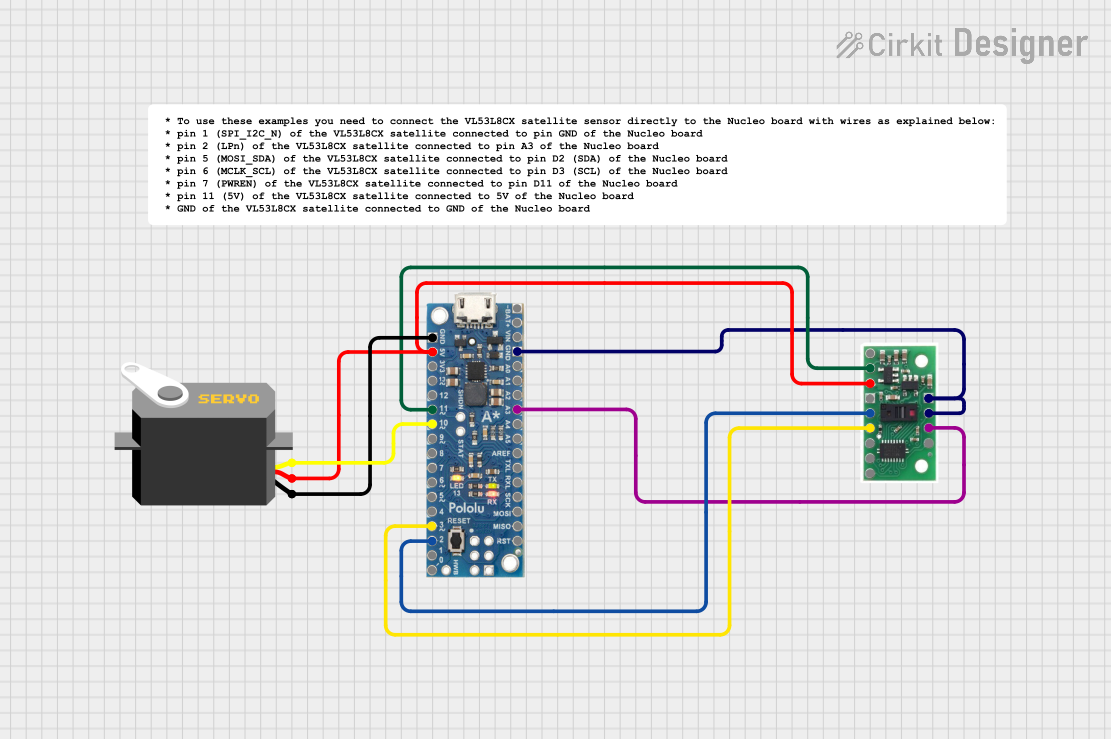
 Open Project in Cirkit Designer
Open Project in Cirkit Designer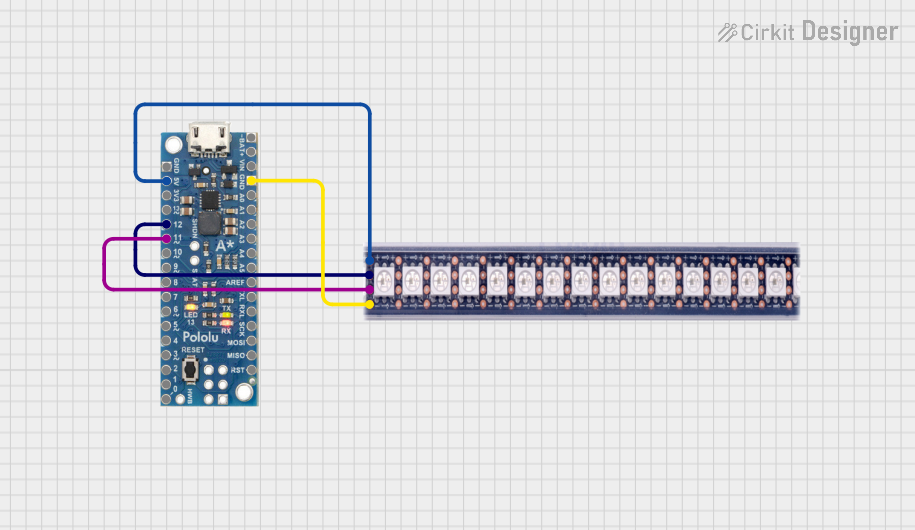
 Open Project in Cirkit Designer
Open Project in Cirkit DesignerExplore Projects Built with A-STAR 32U4 Micro

 Open Project in Cirkit Designer
Open Project in Cirkit Designer
 Open Project in Cirkit Designer
Open Project in Cirkit Designer
 Open Project in Cirkit Designer
Open Project in Cirkit Designer
 Open Project in Cirkit Designer
Open Project in Cirkit DesignerCommon Applications
- Robotics and automation systems
- USB-based data logging and communication
- Wearable electronics
- Prototyping and educational projects
- IoT (Internet of Things) devices
Technical Specifications
The following table outlines the key technical details of the A-STAR 32U4 Micro:
| Specification | Details |
|---|---|
| Microcontroller | ATmega32U4 |
| Operating Voltage | 5V |
| Input Voltage Range | 5V to 15V |
| Flash Memory | 32KB (4KB used by bootloader) |
| SRAM | 2.5KB |
| EEPROM | 1KB |
| Clock Speed | 16 MHz |
| USB Connectivity | Full-speed USB |
| Digital I/O Pins | 18 (7 PWM-capable) |
| Analog Input Pins | 9 |
| Current Draw (Idle) | ~25 mA |
| Dimensions | 1.3" × 0.7" (33 mm × 18 mm) |
Pin Configuration and Descriptions
The A-STAR 32U4 Micro has a total of 24 pins, including power, digital I/O, and analog input pins. The table below provides a detailed description of each pin:
| Pin | Type | Description |
|---|---|---|
| VIN | Power Input | Input voltage (5V to 15V) for powering the board. |
| GND | Ground | Ground connection. |
| 5V | Power Output | Regulated 5V output for external components. |
| A0–A5 | Analog Input | Analog input pins (10-bit resolution). |
| D0–D13 | Digital I/O | General-purpose digital I/O pins (D3, D5, D6, D9, D10, D11, D13 support PWM). |
| TX (D1) | Digital Output | UART transmit pin. |
| RX (D0) | Digital Input | UART receive pin. |
| SDA | Digital I/O | I2C data line. |
| SCL | Digital I/O | I2C clock line. |
| RST | Reset | Resets the microcontroller. |
Usage Instructions
How to Use the A-STAR 32U4 Micro in a Circuit
Powering the Board:
- Connect a power source to the VIN pin (5V to 15V) or use the USB connection for power and communication.
- Ensure the power supply is stable and within the specified voltage range to avoid damage.
Programming the Board:
- The A-STAR 32U4 Micro is compatible with the Arduino IDE. Select "Arduino Leonardo" as the board type in the IDE, as both use the ATmega32U4 microcontroller.
- Connect the board to your computer via USB and upload your code.
Connecting Peripherals:
- Use the digital I/O pins for controlling LEDs, motors, or other devices.
- Use the analog input pins to read sensor data (e.g., temperature, light, or potentiometers).
Using Communication Protocols:
- The board supports UART, I2C, and SPI communication for interfacing with other devices.
Important Considerations and Best Practices
- Avoid exceeding the maximum input voltage of 15V to prevent damage to the board.
- Use decoupling capacitors when connecting sensors or other components to reduce noise.
- When using PWM pins, ensure the connected devices can handle the PWM frequency and voltage levels.
- Always double-check connections to avoid short circuits or incorrect wiring.
Example Code for Arduino UNO Compatibility
The following example demonstrates how to blink an LED connected to pin D13:
// Blink an LED connected to pin D13 on the A-STAR 32U4 Micro
void setup() {
pinMode(13, OUTPUT); // Set pin D13 as an output
}
void loop() {
digitalWrite(13, HIGH); // Turn the LED on
delay(1000); // Wait for 1 second
digitalWrite(13, LOW); // Turn the LED off
delay(1000); // Wait for 1 second
}
Troubleshooting and FAQs
Common Issues and Solutions
The board is not recognized by the computer:
- Ensure the USB cable is functional and supports data transfer (not just charging).
- Check that the correct drivers are installed for the A-STAR 32U4 Micro.
Unable to upload code:
- Verify that "Arduino Leonardo" is selected as the board type in the Arduino IDE.
- Press the reset button on the board just before uploading the code to force it into bootloader mode.
The board is overheating:
- Check the input voltage and ensure it does not exceed 15V.
- Inspect the circuit for short circuits or excessive current draw.
I/O pins are not working as expected:
- Confirm that the pins are correctly configured as input or output in your code.
- Test the pins with a simple program (e.g., toggling an LED) to verify functionality.
FAQs
Q: Can the A-STAR 32U4 Micro be powered solely via USB?
A: Yes, the board can be powered through the USB connection, which also provides communication with a computer.
Q: What is the maximum current output of the 5V pin?
A: The 5V pin can supply up to 500 mA when powered via USB or up to 1A when powered through VIN, depending on the input voltage and the onboard regulator's thermal limits.
Q: Is the A-STAR 32U4 Micro compatible with Arduino shields?
A: No, the A-STAR 32U4 Micro does not have the standard Arduino shield form factor. However, it can interface with shields or modules via jumper wires.
Q: Can I use the board for battery-powered applications?
A: Yes, the board can be powered by a battery (e.g., 7.4V LiPo) connected to the VIN pin, as long as the voltage is within the 5V to 15V range.
This concludes the documentation for the A-STAR 32U4 Micro. For additional support, refer to Pololu's official resources or community forums.